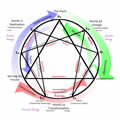Disillusionment with the Reactional Self
2015-02-25
Ken’s comment to ‘yesterday’s’ post includes a quote from Sri Aurobindo. This quote points directly to what is probably the most significant aspect that we need to see and understand about the Reactional Self. Here again is the quote in full…
The day came, however, when Sri Aurobindo had had enough of these intellectual exercises. He probably realized that one can go on amassing knowledge indefinitely, reading and learning languages, even learning all the languages in the world and reading all the books in the world, and yet not progress at all. For the mind does not truly know, even though it may appear to – it seeks to grind. Its need of knowledge is primarily a need for something to grind. If by chance the machine were to come to a stop because knowledge had been obtained, it would soon rise up in revolt and find something new to grind, just for the sake of grinding and grinding; such is its function. That within us which seeks to know and to progress is not the mind, but something behind it which uses it: The capital period of my intellectual development, Sri Aurobindo confided to a disciple, was when I could see clearly that what the intellect said might be correct and not correct, that what the intellect justified was true and its opposite also was true. I never admitted a truth in the mind without simultaneously keeping it open to the contrary of it.... And the first result was that the prestige of the intellect was gone!
There is quite a bit of material to comment on here, but the last sentence is the heart of the matter. The Reactional Self constantly fools us into thinking, feeling and sensing that this outer directed experience of
- knowing more and more,
- having emotional reactions to outer circumstances and events,
- and constantly stimulating the senses of the body through eating, drinking, sex, sports, etc.
is real, that this is where we should live, that what we are experiencing at this moment is true, and that this is what life is all about.
Aurobindo saw through this illusion by seeing the pairs of opposites at the same time. This last phrase, “at the same time”, points to one of the critical requirements for seeing through this illusion. Normally, at any given moment, we are a “prisoner” of one pole of the pair of opposites or we bounce back and forth between the two poles. For example, if my boss at work compliments me I like him and think well of him. “How smart and insightful he is.”… I say to myself. If one minute later he criticizes me, I don’t like him. I say to myself, “What a blind idiot he is.” If a minute after that he says, “I was just joking with you, actually I love what you did, and in fact I’m giving you a promotion because of your work.” I’m flattered and once again I have tremendous respect for his opinion. If he then says, “Boy are you gullible, you’d believe anything I say wouldn’t you? There’s no promotion, now get back to work.”, I’m immediately embarrassed and angry, and once again quite convinced that he’s a blind idiot.
We don’t have to accept a life like this, where we live in reaction to the most recent external event.
But escaping from this world comes at a cost. When we make the choice to see both sides of an event in the same moment, it sets up an inner tension, a real struggle. But if we are willing to go through that struggle, to bear the tension of holding the pairs of opposites in the same present moment, we release energies through which we are able to create something in ourselves that can live in a higher world, free from the pairs of opposites.
Bennett called this ‘something’ the Divided Self, because in addition to being connected to the outer world, it is also connected to our inner world that integrates and reconciles the pairs of opposites. More on that later.
- John Hutcherson's blog
- Log in to post comments

Comments
0
0